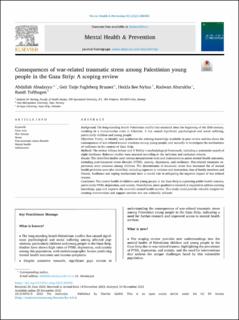| dc.contributor.author | Abudayya, Abdallah | |
| dc.contributor.author | Bruaset, Geir Tarje Fugleberg | |
| dc.contributor.author | Nyhus, Hedda Bøe | |
| dc.contributor.author | Aburukba, Radwan | |
| dc.contributor.author | Tofthagen, Randi | |
| dc.date.accessioned | 2023-11-30T08:15:12Z | |
| dc.date.available | 2023-11-30T08:15:12Z | |
| dc.date.created | 2023-11-29T10:00:46Z | |
| dc.date.issued | 2023 | |
| dc.identifier.citation | Mental health & prevention. 2023, 32 1-15. | en_US |
| dc.identifier.issn | 2212-6570 | |
| dc.identifier.uri | https://hdl.handle.net/11250/3105323 | |
| dc.description.abstract | Background: The long-standing Israeli–Palestinian conflict has escalated since the beginning of the 20th century,
resulting in a humanitarian crisis in Palestine. It has caused significant psychological and social suffering,
particularly children and young people.
Objectives: Firstly, to identify and synthesize the existing knowledge available in peer review articles about the
consequences of war-related trauma reactions among young people, and secondly to investigate the mechanisms
of resilience in the context of Gaza Strip.
Methods: The review follows Arksey and O’Malley’s methodological framework, including a systematic search of
eight databases. Relevant studies were assessed according to the inclusion and exclusion criteria.
Results: The identified studies used various measurement tools and instruments to assess mental health outcomes,
including post-traumatic stress disorder (PTSD), anxiety, depression, and resilience. War-related traumatic ex-
periences were common among children. The determinants of traumatic stress that increased the of mental
health problems were also identified, including exposure to violence and destruction, loss of family members and
friends. Resilience and coping mechanisms have a crucial role in mitigating the negative impact of war-related
trauma.
Conclusion: The mental health of children and young people in the Gaza Strip is a pressing public health concern,
particularly PTSD, depression, and anxiety. Nonetheless, more qualitative research is required to address existing
knowledge gaps and improve the available mental health service. This study could provide valuable insights for
creating interventions and support services that are culturally tailored. | en_US |
| dc.language.iso | eng | en_US |
| dc.rights | Navngivelse 4.0 Internasjonal | * |
| dc.rights.uri | http://creativecommons.org/licenses/by/4.0/deed.no | * |
| dc.subject | Gaza | en_US |
| dc.subject | Gaza | en_US |
| dc.subject | Barn og unge | en_US |
| dc.subject | Children and young people | en_US |
| dc.subject | Traumatisk stress | en_US |
| dc.subject | Traumatic stress | en_US |
| dc.subject | Posttraumatisk stresslidelse | en_US |
| dc.subject | Post-traumatic stress disorder | en_US |
| dc.title | Consequences of war-related traumatic stress among Palestinian young people in the Gaza Strip: A scoping review | en_US |
| dc.type | Peer reviewed | en_US |
| dc.type | Journal article | en_US |
| dc.description.version | publishedVersion | en_US |
| cristin.ispublished | true | |
| cristin.fulltext | original | |
| cristin.qualitycode | 1 | |
| dc.identifier.doi | 10.1016/j.mhp.2023.200305 | |
| dc.identifier.cristin | 2204745 | |
| dc.source.journal | Mental health & prevention | en_US |
| dc.source.volume | 32 | en_US |
| dc.source.pagenumber | 1-15 | en_US |
| dc.subject.nsi | VDP::Helsefag: 800 | en_US |
| dc.subject.nsi | VDP::Health sciences: 800 | en_US |

